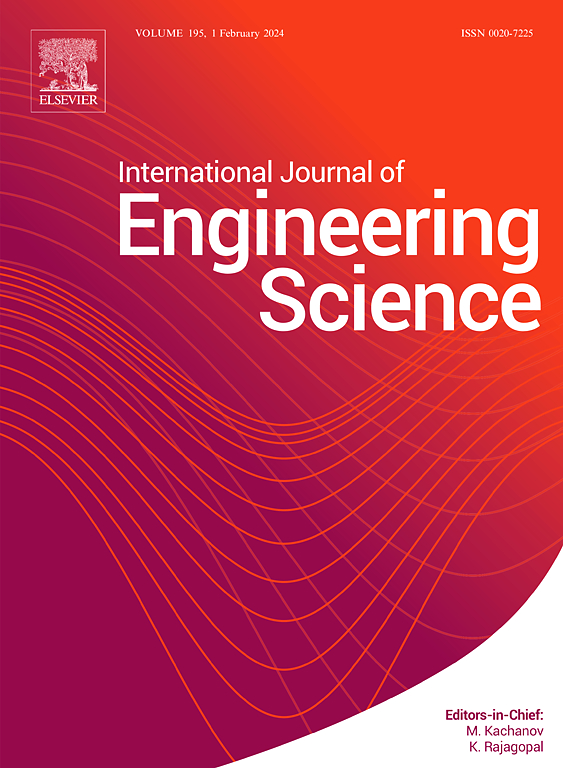体心立方微/纳米晶格尺寸效应的封闭分析
IF 5.7
1区 工程技术
Q1 ENGINEERING, MULTIDISCIPLINARY
International Journal of Engineering Science
Pub Date : 2025-06-19
DOI:10.1016/j.ijengsci.2025.104311
引用次数: 0
摘要
微/纳米晶格结构具有优异的机械性能,使其在微/纳米器件和航空航天领域的应用前景非常广阔。然而,现有的研究主要集中在三维微/纳米晶格的压缩和弯曲实验研究上,导致对影响其宏观行为的尺寸依赖机制的理解有限。为了解决这一差距,本研究开发了一种跨尺度分析模型,该模型集成了修正耦合应力理论和Timoshenko梁理论,从而能够对体心立方(BCC)微/纳米晶格单元细胞进行全面分析。该模型是通过变分计算,利用哈密顿原理推导出来的,同时考虑了泊松比和尺寸效应。利用Navier方法,建立了长度尺度参数与准静态条件下单体胞的宏观响应之间的解析关系。通过实验数据验证了该模型预测响应的有效性。参数分析表明,在BCC微/纳米晶格单元胞响应评价中,当无量纲参数d/l小于10时,尺寸效应不可忽视。在衬底参数和尺寸效应的共同影响下,晶胞同时表现出线性和非线性的力学行为,甚至具有显著的奇异特性。特别是,强烈的尺寸效应导致单元胞的负泊松比特征。该研究不仅弥补了尺寸效应下微/纳米晶格响应评价的理论空白,而且为微/纳米晶格器件和航天器件领域的优化设计提供了坚实的理论支持。本文章由计算机程序翻译,如有差异,请以英文原文为准。
Closed-form analysis of the size effects in Body-centered cubic micro-/nanolattices
Micro-/nanolattice structures exhibit exceptional mechanical properties, making them highly promising for applications in micro/nano devices and aerospace areas. However, existing research has primarily focused on experimental studies of compression and bending in three-dimensional micro-/nanolattices, resulting in a limited understanding of the size-dependent mechanisms influencing their macroscopic behavior. To address this gap, this study develops a trans-scale analytical model that integrates modified couple stress theory and Timoshenko beam theory, enabling a comprehensive analysis of body-centered cubic(BCC) micro-/nanolattice unit cells. The model is derived using the Hamiltonian principle through variational calculations, taking into account both Poisson’s ratio and size effects. Utilizing Navier’s method, an analytical relationship is established between the length scale parameter and the macroscopic response of the unit cell under quasi-static conditions. The effectiveness of the model in predicting responses is validated against experimental data. Parameter analysis reveals that size effects cannot be neglected when the dimensionless parameter is less than 10 in BCC micro-/nanolattice unit cell response evaluations. Under the combined influence of substrate parameters and size effects, the unit cell exhibits both linear and nonlinear mechanical behaviors, even notable singular features. In particular, strong size effects result in a negative Poisson’s ratio feature of the unit cell. This study not only bridges the theoretical gap in evaluating the response of micro-/nanolattices under size effects but also provides solid theoretical support for the optimized design of micro-/nanolattice devices and aerospace devices area.
求助全文
通过发布文献求助,成功后即可免费获取论文全文。
去求助
来源期刊

International Journal of Engineering Science
工程技术-工程:综合
CiteScore
11.80
自引率
16.70%
发文量
86
审稿时长
45 days
期刊介绍:
The International Journal of Engineering Science is not limited to a specific aspect of science and engineering but is instead devoted to a wide range of subfields in the engineering sciences. While it encourages a broad spectrum of contribution in the engineering sciences, its core interest lies in issues concerning material modeling and response. Articles of interdisciplinary nature are particularly welcome.
The primary goal of the new editors is to maintain high quality of publications. There will be a commitment to expediting the time taken for the publication of the papers. The articles that are sent for reviews will have names of the authors deleted with a view towards enhancing the objectivity and fairness of the review process.
Articles that are devoted to the purely mathematical aspects without a discussion of the physical implications of the results or the consideration of specific examples are discouraged. Articles concerning material science should not be limited merely to a description and recording of observations but should contain theoretical or quantitative discussion of the results.
 求助内容:
求助内容: 应助结果提醒方式:
应助结果提醒方式:


